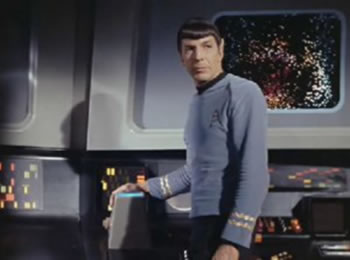Science Fiction
Dictionary
A B C D E F G H I J K L M N O P Q R S T U V W X Y Z
Can 'Dimers' Be Used For Star Trek's Long Range Sensors?

As much as I loved Star Trek in the 1960's, there were some elements of the series' pseudoscience that made me wince. One of them was the idea of a long range sensor that could detect life readings on distant planets. How could you possibly detect life at a distance of light years?
It turns out that it might be possible after all.
Astronomers have found a way to determine the atmospheric pressure of far away worlds using "dimers", molecules that couple to form larger, more complex molecules. In particular, two oxygen molecules.
This method is demonstrated by using the O2 A band and the 1.06 μm dimer feature, either in transmission or reflected spectra. It works best for planets around M dwarfs with atmospheric pressures between 0.1 and 10 bar and for O2 volume mixing ratios above 50% of Earth's present-day level.
Furthermore, unlike observations of Rayleigh scattering, this method can be used at wavelengths longer than 0.6 μm and is therefore potentially applicable, although challenging, to near-term planet characterization missions such as JWST. We also performed detectability studies for JWST transit transmission spectroscopy and found that the 1.06 and 1.27 μm dimer features could be detectable (SNR>3) for an Earth analogue orbiting an M5V star at a distance of 5 pc.
The detection of these features could provide a constraint on the atmospheric pressure of an exoplanet and serve as biosignatures for oxygenic photosynthesis.
We calculated the required signal-to-noise ratios to detect and characterize O2 monomer and dimer features in direct imaging–reflected spectra and found that signal-to-noise ratios greater than 10 at a spectral resolving power of R=100 would be required.
So, given that this method works (there are others), maybe Spock was right all along.
We present a new method to probe atmospheric pressure on Earth-like planets using (O2-O2) dimers in the near-infrared. We also show that dimer features could be the most readily detectable biosignatures for Earth-like atmospheres and may even be detectable in transit transmission with the James Webb Space Telescope (JWST). The absorption by dimers changes more rapidly with pressure and density than that of monomers and can therefore provide additional information about atmospheric pressures. By comparing the absorption strengths of rotational and vibrational features to the absorption strengths of dimer features, we show that in some cases it may be possible to estimate the pressure at the reflecting surface of a planet.

(Spock long range sensor scan)
From Using Dimers to Measure Biosignatures and Atmospheric Pressure for Terrestrial Exoplanets (pdf) via ScienceMag.
Scroll down for more stories in the same category. (Story submitted 3/13/2014)
Follow this kind of news @Technovelgy.| Email | RSS | Blog It | Stumble | del.icio.us | Digg | Reddit |
Would
you like to contribute a story tip?
It's easy:
Get the URL of the story, and the related sf author, and add
it here.
Comment/Join discussion ( 1 )
Related News Stories - (" Space Tech ")
Will Space Stations Have Large Interior Spaces Again?
'They filed clumsily into the battleroom, like children in a swimming pool for the first time, clinging to the handholds along the side.' - Orson Scott Card, 1985.
Reflect Orbital Offers 'Sunlight on Demand' And Light Pollution
'I don't have to tell you about the seven two-mile-diameter orbital mirrors...'
Chrysalis Generation Ship to Alpha Centauri
'This was their world, their planet —
this swift-traveling, yet seemingly moveless vessel.' - Nat Schachner, 1934
The First Space Warship For Space Force
'Each of the electrical ships carried about twenty men...' - Garrett P. Serviss, 1898.
Technovelgy (that's tech-novel-gee!) is devoted to the creative science inventions and ideas of sf authors. Look for the Invention Category that interests you, the Glossary, the Invention Timeline, or see what's New.
Science Fiction
Timeline
1600-1899
1900-1939
1940's 1950's
1960's 1970's
1980's 1990's
2000's 2010's
Current News
Sunday Robotics 'Memo
'He then started hand movements of definite pattern...'
Woman Marries Computer, Vonnegut's Dream Comes True
'Men are made of protoplasm... Lasts forever.'
Natural Gait With Prosthetic Connected To Nervous System
'The leg was to function, in a way, as a servo-mechanism operated by Larry’s brain...'
Spidery 'Walk Me' Toyota Autonomous Wheel Chair Like Star Wars
Walk along with the emperor.
Dancing Robots Taught Dance Moves
'A clockwork figure would be the thing for you...'
Proof Of Robothood - Not A Person
'Who are you people? - Show 'em.'
Indonesian Clans Battle
'The observation vehicle was of that peculiar variety used in conveying a large number of people across rough terrain.'
The 'Last Mile' In China Crowded With Delivery Robots
Yes, it's a delivery robot. On wheels.
Tornyol Microdrone Kills Mosquitoes
'The real border was defended by... a swarm of quasi-independent aerostats.'
PLATO Spacecraft, Hunter Of Habitable Planets, Now Ready
'I ... set my automatic astronomical instruments to searching for a habitable planet.'
Factory Humanoid Robots Built By Humanoid Robots
'...haven't you a section of the factory where only robot labor is employed?'
iPhone Air Fulfils Jobs' Promise From 2007 - A Giant Screen!
'... oblongs were all over the floor and surfaces.'
ChatGPT Now Participates in Group Chats
'...the city was their laboratory in human psychology.'
iPhone Pocket All Sold Out!
'A long, strong, slender net...'
Did The Yautja Have These First?
What a marvel of ingenuity the little device was!
Jetson ONE Air Races Begin, Can Air Polo Be Far Behind?
'If you're one of those rarities who haven't attended a rocket-polo "carnage", let me tell you it's a colorful affair.'
